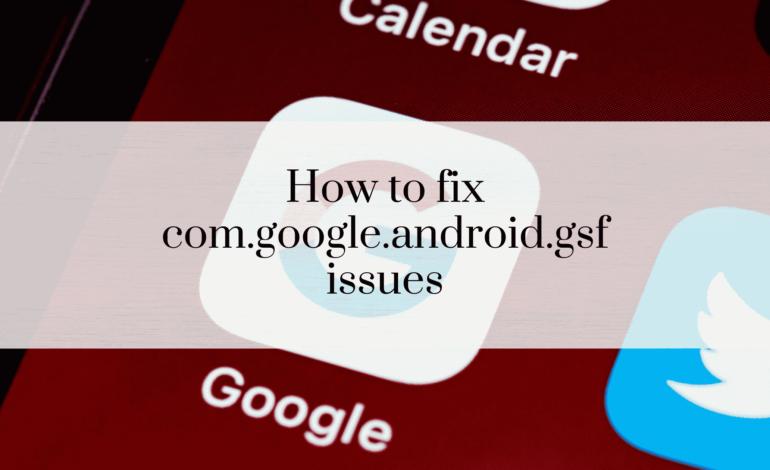How to fix com.google.android.gsf issues

Introduction to com.google.android.gsf
What is com.google.android.gsf?
The com.google.android.gsf stands for Google Services Framework. It’s a critical system service that ensures your Android device can communicate efficiently with Google’s servers. It manages essential background tasks, such as syncing your Google account data, sending push notifications, and ensuring app updates run smoothly.
Role in Android Systems
This framework operates as the backbone for all Google-related services on your device. It handles authentication, updates, and synchronization for apps like Gmail, Google Drive, and YouTube.
Why Issues Arise
Problems with com.google.android.gsf can result from corrupted system files, outdated software, or conflicts with third-party apps. These issues often lead to errors that impact the overall performance of your device.
Common Issues with com.google.android.gsf
App Crashes
One of the most frequent symptoms of a malfunctioning Google Services Framework is sudden app crashes. Apps relying on Google Play Services often fail to operate smoothly, leaving users frustrated.
Battery Drain
A faulty com.google.android.gsf can cause significant battery drainage. This happens because the framework may run processes in the background incessantly, even when they’re not needed.
Network Connectivity Problems
Issues with com.google.android.gsf can disrupt network-dependent functionalities, such as app updates, push notifications, and cloud backups.
Sync Errors
Users may notice their Google account fails to sync. This could affect your ability to send and receive emails, save files to Google Drive, or sync calendar entries.
Understanding the Importance of com.google.android.gsf
Core Functions in Android Ecosystem
The com.google.android.gsf is crucial for a stable and seamless Android experience. It helps authenticate your account, allowing apps to use Google’s infrastructure for a wide range of services.
Integration with Google Services
Without the Google Services Framework, apps like Google Maps, Gmail, and Google Photos can lose their ability to sync data or access real-time updates.
Preliminary Steps to Identify Problems
Checking Error Logs
To pinpoint the root cause, start by reviewing your device’s error logs. This will help identify specific errors linked to com.google.android.gsf.
Verifying App Permissions
Sometimes, issues arise due to insufficient app permissions. Ensure the Google Services Framework has the necessary permissions to access your device’s resources.
Assessing Recent Changes
Think back to recent changes made on your device. New apps, system updates, or modified settings could be the source of the problem.
Read Now: What is com.google.android.apps.nexuslauncher?
Step-by-Step Guide to Fix com.google.android.gsf Issues
Clear Cache and Data of the Google Services Framework
- Go to Settings > Apps > Show System Apps.
- Locate Google Services Framework.
- Tap Storage > Clear Cache and Clear Data.
This often resolves minor glitches.
Uninstall Updates to Google Play Services
Reverting Google Play Services to its factory version can eliminate compatibility issues.
- Go to Settings > Apps.
- Select Google Play Services.
- Tap Uninstall Updates.
Reinstall Google Play Services
Download the latest version of Google Play Services to ensure compatibility:
- Visit the Google Play Store.
- Search for Google Play Services and update it.
Reset App Preferences
This resets all app permissions and default apps without deleting data:
- Go to Settings > Apps.
- Tap the three-dot menu and select Reset App Preferences.
Check for System Updates
An outdated Android version may cause compatibility issues:
- Go to Settings > System > Software Update.
- Install any available updates.
Advanced Troubleshooting Techniques
Factory Reset: Pros and Cons
A factory reset wipes all data and restores your device to its original state. This is often a last resort for persistent issues.
Flashing Stock Firmware
For advanced users, flashing the original firmware can resolve software corruption. This requires downloading the correct ROM for your device.
Using ADB Commands for Targeted Fixes
ADB (Android Debug Bridge) commands can help debug and fix specific issues without resetting the entire device.
Rooted Devices: Additional Options
Rooted users can modify system files and install custom ROMs for a more tailored solution.
Preventive Measures for Future Issues
Regular Updates
Keeping your system and apps updated helps prevent compatibility issues with com.google.android.gsf.
Avoiding Third-Party App Conflicts
Some third-party apps may interfere with system processes. Stick to trusted apps from the Google Play Store.
Importance of System Backups
Regular backups ensure that even if issues arise, you won’t lose valuable data.
FAQs
How to Know if com.google.android.gsf is Corrupted?
Look for frequent app crashes, sync errors, or high battery usage in your system settings.
Can I Disable com.google.android.gsf?
Disabling it is not recommended as it’s integral to Google services. Your apps may lose critical functionality.
Will Factory Reset Solve All Issues?
A factory reset can fix most issues but should be used as a last resort.
Why Does com.google.android.gsf Use So Much Battery?
Continuous background syncs and data transfers can drain the battery.
What Happens If I Ignore com.google.android.gsf Errors?
Ignoring these errors can lead to degraded performance, app malfunctions, and security vulnerabilities.
Are There Alternatives to com.google.android.gsf?
No official alternatives exist, but custom ROMs may provide different frameworks.
Conclusion
Addressing com.google.android.gsf issues ensures your Android device operates at its best. By following the steps outlined above, you can resolve most common problems and maintain a smooth user experience.







